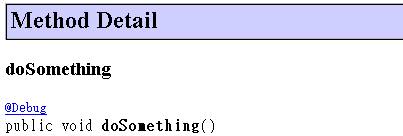在定義Annotation型態時,使用java.lang.annotation.Target可以定義其適用之時機,在定義時可以指定java.lang.annotation.ElementType的列舉值:
package java.lang.annotation;
public enum ElementType {
TYPE, // 適用 class, interface, enum
FIELD, // 適用 field
METHOD, // 適用 method
PARAMETER, // 適用 method 上之 parameter
CONSTRUCTOR, // 適用 constructor
LOCAL_VARIABLE, // 適用區域變數
ANNOTATION_TYPE, // 適用 annotation 型態
PACKAGE // 適用 package
}
public enum ElementType {
TYPE, // 適用 class, interface, enum
FIELD, // 適用 field
METHOD, // 適用 method
PARAMETER, // 適用 method 上之 parameter
CONSTRUCTOR, // 適用 constructor
LOCAL_VARIABLE, // 適用區域變數
ANNOTATION_TYPE, // 適用 annotation 型態
PACKAGE // 適用 package
}
舉個例子來說,假設你定義Annotation只能適用於constructor與method:
package cc.openhome;
import java.lang.annotation.Target;
import java.lang.annotation.ElementType;
@Target({ElementType.CONSTRUCTOR, ElementType.METHOD})
public @interface Debug {}
import java.lang.annotation.Target;
import java.lang.annotation.ElementType;
@Target({ElementType.CONSTRUCTOR, ElementType.METHOD})
public @interface Debug {}
如果你嘗試將Debug用於class上:
package cc.openhome;
@Debug
public class SomeObject {
public void doSomething() {
// ....
}
}
@Debug
public class SomeObject {
public void doSomething() {
// ....
}
}
則在編譯時會發生以下的錯誤:
SomeObject.java:3: annotation type not applicable to this kind of declaration
@Debug
^
1 error
@Debug
^
1 error
在製作JavaDoc文件時,預設上並不會將Annotation的資料加入到文件中,Annotation用於為程式碼作註解,有時它包括了重要的訊息,你也許會想要使用者製作文件的同時,也一併將Annotation的訊息加入,你可以 使用java.lang.annotation.Documented,例如:
package cc.openhome;
import java.lang.annotation.Documented;
import java.lang.annotation.Retention;
import java.lang.annotation.RetentionPolicy;
@Documented
@Retention(RetentionPolicy.RUNTIME)
public @interface Debug {}
import java.lang.annotation.Documented;
import java.lang.annotation.Retention;
import java.lang.annotation.RetentionPolicy;
@Documented
@Retention(RetentionPolicy.RUNTIME)
public @interface Debug {}
使用java.lang.annotation.Documented時,同時的你必須使用Retention指定編譯器將訊 息加入class檔案,並可以由VM讀取,即設定RetentionPolicy為RUNTIME,接著你可以重新產生Java Doc文件,這次可以看到文件中包括了@Debug的訊息。

在你定義Annotation型態後並使用於程式碼上時,預設上父類別中的Annotation並不會被繼承至子 類別中,你可以在定義 Annotation時加上java.lang.annotation.Inherited的Annotation,這讓你定義的Annotation型 別被繼承下來。例如:
package cc.openhome;
import java.lang.annotation.Retention;
import java.lang.annotation.RetentionPolicy;
import java.lang.annotation.Inherited;
@Retention(RetentionPolicy.RUNTIME)
@Inherited
public @interface Debug {
String value();
String name();
}
import java.lang.annotation.Retention;
import java.lang.annotation.RetentionPolicy;
import java.lang.annotation.Inherited;
@Retention(RetentionPolicy.RUNTIME)
@Inherited
public @interface Debug {
String value();
String name();
}

